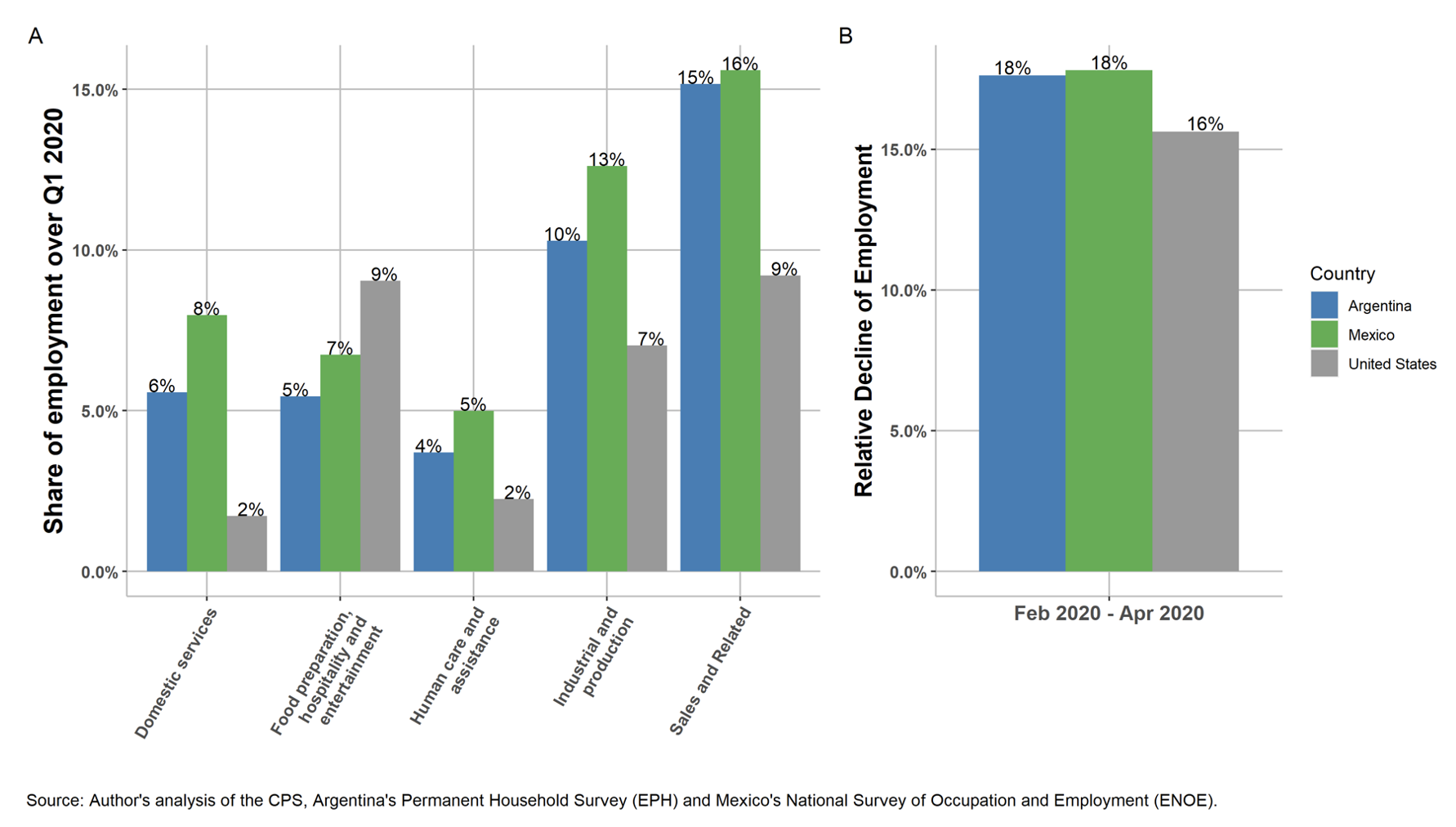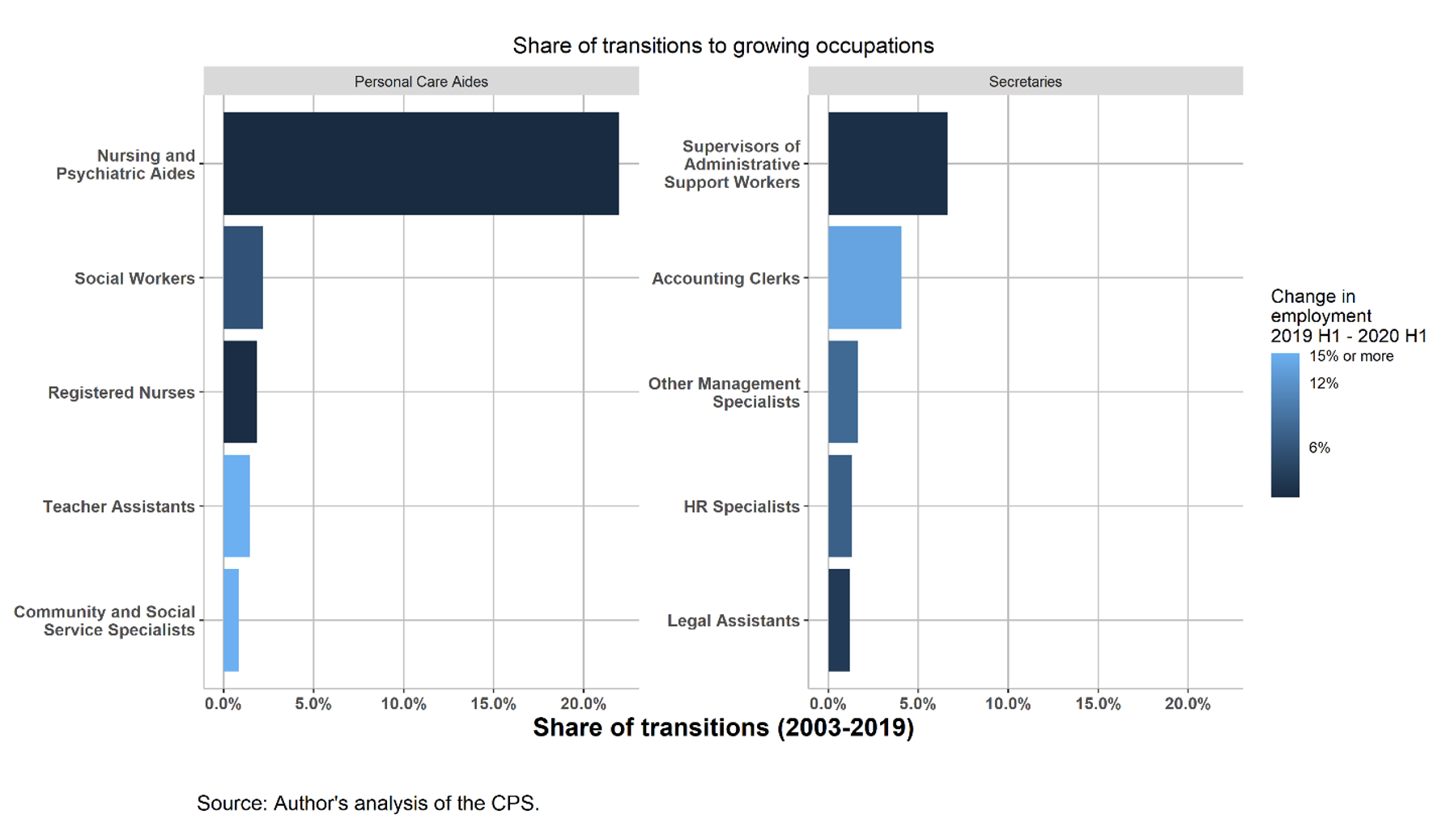In 2020, GDP in Latin America and the Caribbean (LAC) is expected to contract by 8.1% compared to only 4.3% in the US. Relative to pre-pandemic expectations, downward revisions to growth in 2020 has been 3.5 percentage points higher in LAC than in the US. And this divergence is likely to endure: according to the IMF, “most countries [in LAC] will not go back to pre-pandemic GDP until 2023, and real income per capita until 2025,” whereas the US is expected to recover fully by 2022.
What is behind the asymmetric consequences of COVID-19?
Whereas differences in access to international capital and fiscal space may have played a part, most of the short-lived spike in Latin American sovereign spreads was offset by the flattening of international interest rates and rapidly reversed, with a neutral net effect in financing costs (Levy Yeyati and Valdés 2020). Instead, the nature of the labour market can help explain North-South differences in the immediate –and long-lasting– impact of the pandemic on growth, poverty, inequality, and welfare.
The labour market channel
From the 1990s through the early 2000s, labour markets in the US and other developed economies experienced the influence of two main global drivers: globalisation (in particular, the integration of the Chinese economy into global value chains) and, more recently, the acceleration of technological change, which concurrently led to a decline in the demand for routine, middle-skill workers and labor market polarisation (Autor and Dorn 2009), along with a growing share of (gig and freelance) independent work. Over time, polarisation (the orange U-shaped curve for 2009-2014 in Figure 1) turned into job inequality (represented by the upward-sloping curve for 2014-2019). Preliminary data from 2020 point to a deepening of this shift (the inverted U-curve for 2019-2020), as COVID-related restrictions hit primarily low-wage, high-contact jobs such as cleaning, hospitality, or health care activities, and the fact that remote jobs often require skills or hardware that low-wage workers may not have.
Figure 1 Recent US employment trends show low-wage workers hit hard
This pattern, if persistent, does not bode well for developing economies. Take, for example, the case of Latin America. While the adoption of new technologies has been slower, due in part to the relative abundance of unskilled labor, resulting in less labor market polarisation (Busso and Messina 2020) and even declining inequality (Messina and Silva 2019), albeit from very high levels and for varied reasons (Levy yeyati and Pienknagura 2014), Latin America’s relatively unskilled labour force suggests that the COVID impact may be larger and more persistent than in the US.1
Compared to the US, employment in Latin American countries is more heavily concentrated in the high-contact, non-remotable occupations (Lopez-Calva 2020, Figure 2). The five hardest-hit occupations represent 29% of jobs in the US, whereas in Argentina and Mexico, they represent 40% and 47%, respectively.
Figure 2 Argentina and Mexico have more workers in the hardest-hit occupations
Note: The comparison of participation rates by occupation was accomplished by collapsing occupation-detailed employment data into 34 comparable occupational groups based on Argentina’s National Occupation Classification. Figure 2b estimates the counterfactual employment changes in the US by applying the US’s percentage change in occupational employment to Argentina’s and Mexico’s occupational structure.
But perhaps the key aspect of the labour market channel lies in a distinctive feature of developing economies: the precariousness of their workforce. In Latin America, about half of the workers are informal wage-earners or self-employed without a college degree (Busso and Messina 2020); in Bolivia, Nicaragua, Paraguay, and Peru, more than two-thirds of workers are informal. Consequently, many of these workers live beyond the reach of traditional government support programs such as wage subsidies, furlough schemes or unemployment insurance. Thus, while many Latin American countries offer generous labour protections to salaried workers (in Argentina, for instance, the doubling of severance payments prior to the pandemic was followed by a layoff ban that was still in place by end-2020),2 most informal and independent workers lack protections altogether. Thus, even in countries with significant fiscal space, informality and self-employment limit the ability to assign resources, in turn reducing the effectiveness of social distancing (Levy Yeyati and Sartorio 2020).
A post-pandemic labour agenda
The extent to which current changes will become permanent remains uncertain. Now that companies have learned to operate with fewer active workers, they are unlikely to unlearn (Ding and Molina 2020). In developed economies, pandemic-induced automation and digitalization can be expected to create jobs in mostly high-skill occupations, whereas less travel and more remote work will likely dampen demand for less-skilled service work (Autor and Reynolds 2020) –the exception being precarious, labour intensive deliveries
Against this background, evidence-based active labour market policies (Levy Yeyati et al. 2020) will be critical to navigate the transition. An illustration of this approach is the Occupation Space (OS), a network of historical job-to-job transition data,3 built to orient the training of vulnerable workers to ‘high-value’ (high-mobility, high-upside) occupations that match the worker´s competencies and skills (Figure 3). According to the OS, Personal Care Aides, an occupation recently in decline, is close to Nursing and Psychiatric Aides, more resilient to the current crisis: the former, with targeted training and support, may transition to the latter.14 Based on this metric, the potential for ‘high-value’ occupations in the US to absorb the country’s unemployed workers is at its lowest point since at least 2004. Actively facilitating these transitions will be important given the scale of job loss.
Figure 3 Job transition data show viable opportunity for workers in hard-hit occupations.
Note: Historical job transition data show viable opportunity for workers in declining occupations to move into growing occupations, given the frequency with which those transitions occurred in the past.
The unbearable lightness of being self-employed
Even a targeted evidence-based reskilling program will need to adapt and broaden its scope to address the needs of independent workers—particularly in the developing world where they are a growing and relatively unskilled majority. Because not all precarious workers will access formal jobs –there is simply not sufficient demand in the private sector for all of them–training policies will need to target free-lancers and micro entrepreneurs as well, to improve their productivity and labour income.
At any rate, the future of work calls for a new regime for non-salaried workers (Levy Yeyati and Sartorio 2020), halfway between the precarity of self-employment and the rigidity of highly protected salaried work, where benefits are portable (tied not to a job, but to the hours worked) to stabilise the labour income of these precarious –and growing– portion of the labour force. Indeed, a transitional, portable-benefit employment regime could also be applied, Austrian-style, to regular jobs during the ongoing labour market emergency. In both cases, the new regimes would foster labour inclusion. In addition, they should contribute to attenuate fiscal and social security imbalances, as they provide a bridge to job formalisation, broadening the tax base.
Targeted training and new regulation is, therefore, the labour inclusion agenda opened by the pandemic in the global South. The labour market channel was a critical driver of the differential welfare impact of COVID-19 in the developing world. It should also be the way to rebuild a better, more inclusive economy the day after.
References
Autor, D H and D Dorn (2009), “The Growth of Low Skill Service Jobs and the Polarization of the U.S. Labor Market”, NBER Working Paper No. 15150.
Busso, M and J Messina (2020), “The Inequality Crisis: Latin America and the Caribbean at the Crossroads”, Inter-American Development Bank.
Messina, J and J Silva (2019), “Twenty Years of Wage Inequality in Latin America”, IDB Working Paper Series No. IDB-WP-1041.
Levy yeyati, E and S Pienknagura (2014), “Wage compression and the decline in inequality in Latin America: Good or bad?”, VoxEU.org, 10 June.
López-Calva, L F (2020), “Working in Times of Pandemic: Only one in five workers in LAC can actually work from home”, United Nations Development Programme, Latin America.
Buenos Aires Times (2020), “Government extends ban on unjust lay-offs for another two months”, 19 May.
Levy Yeyati, E and L Sartorio (2020), “Work after COVID: A new regime for independent workers”, VoxEU.org, 16 April.
Ding, L and J S Molina (2020), “`Forced Automation’ by COVID-19? Early Trends from Current Population Survey Data”, Federal Reserve Bank of Philadelphia.
Autor, D and E Reynolds (2020), “The Nature of Work after the COVID Crisis: Too Few Low-Wage Jobs”, The Hamilton Project.
Levy Yeyati, E, M Montané and L Sartorio (2020), “Life after coronavirus: Strengthening labor markets through active policy”, Brookings Institution, 20 April.
Levy Yeyati, E and M Montané (2020), “Specificity of Human Capital: An Occupation Space Based on Job-to-Job Transitions.”
Endnotes
1 When comparing employment data, one has to bear in mind that in the US, the absence of furlough schemes imply that, unlike in most Latin American countries, temporarily suspended workers are added to the unemployed; hence, the sharp peak and fast decline in temporary unemployment in the US in the first semester, and the plateauing once labour dynamics start to reflect permanent layoffs.
2 “Government extends ban on unjust lay-offs for another two months”, Buenos Aires Times, 19 May 2020.
3 See https://www.brookings.edu/interactives/wof-mobility-pathways/
4 For a similar analysis based on Argentine data, see also Levy Yeyati and Montané (2020).






